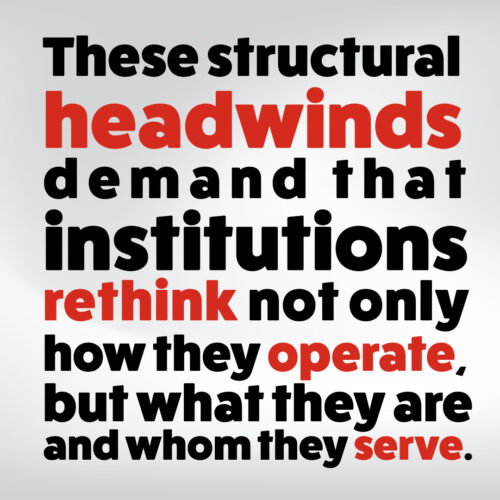Higher education is at a crossroads. For more than a decade, institutions have been bracing for the long-anticipated enrollment cliff—a demographic reality that is no longer on the horizon but here today.  Simultaneously, declining public trust, pressure from state and national politicians on policies and practices, changing student demographics, rising operating costs, escalating deferred maintenance, questions about perceived value, and an increasingly complex student mental health landscape are accelerating a reckoning across the sector. These structural headwinds demand that institutions rethink not only how they operate, but what they are and whom they serve. The institutions that survive—and thrive—will be those willing to confront a hard truth: the traditional higher education approach is no longer sustainable. Transformative change is not optional. It’s essential.
Simultaneously, declining public trust, pressure from state and national politicians on policies and practices, changing student demographics, rising operating costs, escalating deferred maintenance, questions about perceived value, and an increasingly complex student mental health landscape are accelerating a reckoning across the sector. These structural headwinds demand that institutions rethink not only how they operate, but what they are and whom they serve. The institutions that survive—and thrive—will be those willing to confront a hard truth: the traditional higher education approach is no longer sustainable. Transformative change is not optional. It’s essential.
Successfully navigating these complex systemic challenges will require institutions to collaborate thoughtfully across internal silos and to bring together key stakeholders—students, parents, employers, legislators, boards, and others—to ask difficult questions, make hard decisions and build comprehensive roadmaps to achieve long term sustainability.
According to the National Association of College & University Business Officers, these road maps should include strategies to:
Successfully addressing these issues for long-term sustainability will require structures that align decision-making with strategic priorities and mission; ensure investments are optimized to deliver maximum impact; support the development and implementation of an actionable and agile plan; and a representative spectrum of key internal and external stakeholders in the process.
What’s next: The future-ready campus
This moment calls for bold action—and no institution can afford to stand still. This essay is the launch of The Future-Ready Campus, a thought leadership series exploring the strategies, structures, and decision-making approaches that are helping colleges and universities navigate the realities of today’s landscape and reimagine what’s possible. Each installment will unpack real-world examples, challenge conventional thinking, and spark new conversations about the future of higher education within the context of the list above. Whether you’re confronting enrollment pressures, constrained resources, or questions of long-term relevance, we invite you to explore what transformation can truly look like—and how to lead it.
TJ Logan and James Vigil are seasoned leaders at Brailsford & Dunlavey, bringing a combined five decades of experience in higher education administration and strategic consulting. Logan, Executive Director of the firm’s higher education practice, specializes in student housing, auxiliary services, and student affairs. Prior to joining B&D, he served as associate vice president for the Residential Experience at The Ohio State University, where he focused on sustainable auxiliary operations and financial models. He holds an Ed.D. in Educational Technology from the University of Florida and an MBA from Kent State University. He can be reached tlogan@bdconnect.com.
James Vigil, Director at B&D’s management advisory practice, offers 30 years of expertise in higher education administration, including finance, auxiliaries, facilities, information technology, and public safety. Before joining B&D, he was Vice President for Administration and Interim CFO at Shepherd University, leading initiatives in organizational restructuring and capital investment planning. He earned his M.A. in Corporate Communications from West Virginia University and a B.A. in Business Administration from the University of St. Thomas. He can be reached at jvigil@bdconnect.com.